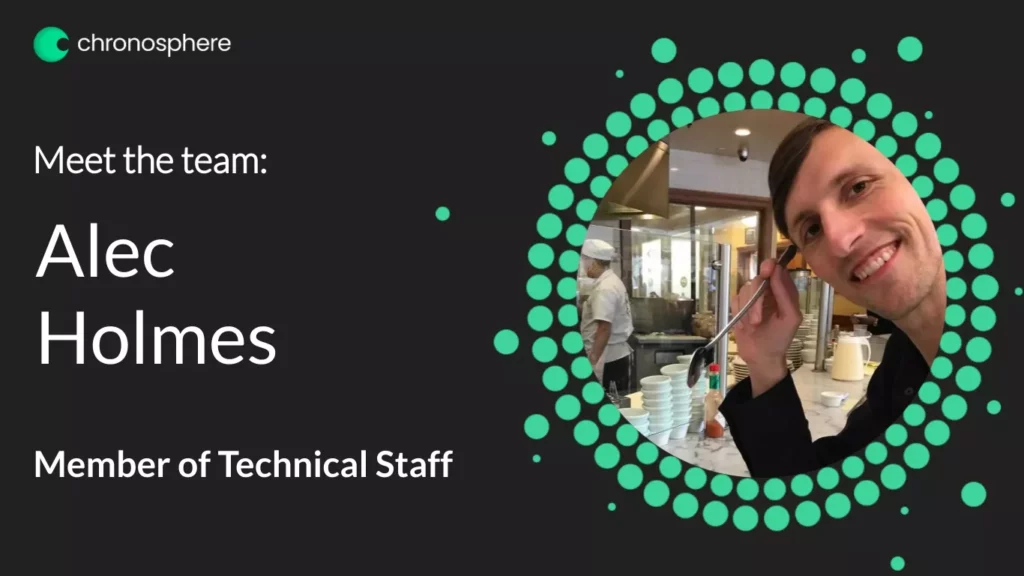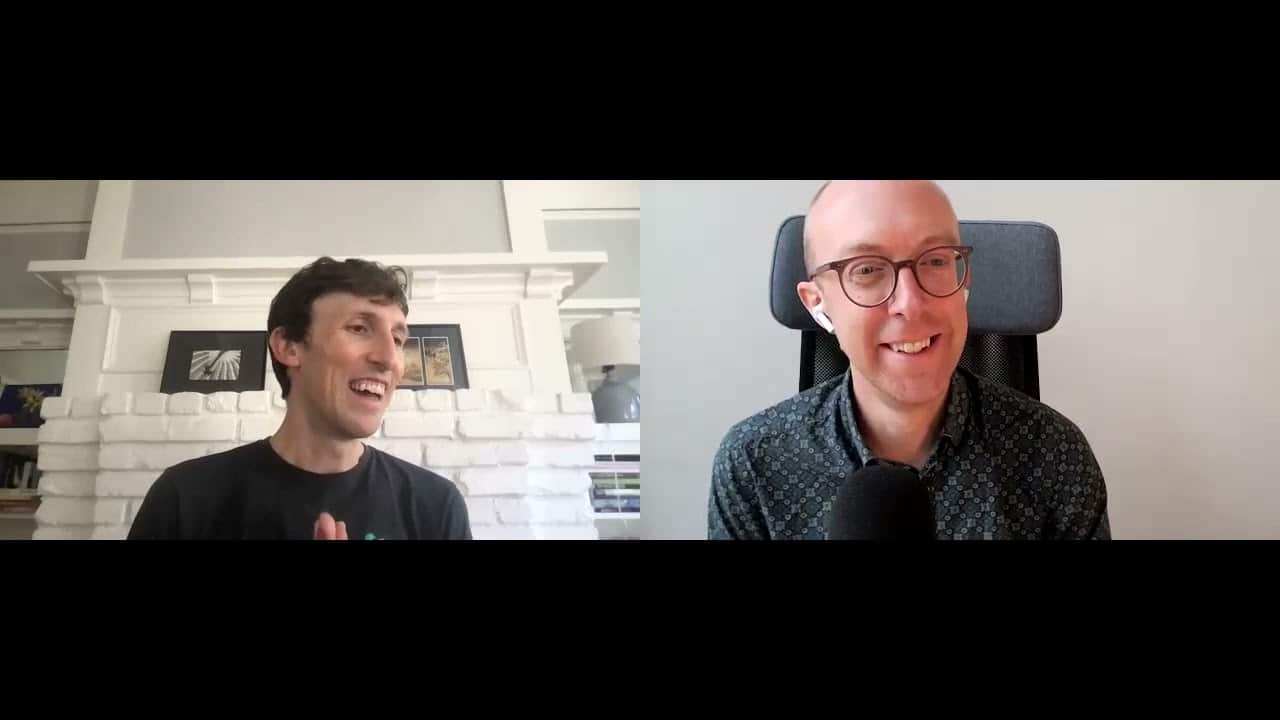
In today’s “Meet the Chronosphere Team” profile, we talk to Alec Holmes, who is a Member of Technical Staff (MTS) and a critical member of Chronosphere’s growing West Coast Team.

On: Sep 10, 2021
The Chronosphere team is growing so fast, and in so many locations, it’s challenging to shine the spotlight fast enough – but we’re going to keep going because we love to share our stories. In today’s “Meet the Chronosphere Team” profile, you’ll get to know Alec Holmes, a critical member of our growing West Coast Team. Alec joined the team almost a year ago, and in this piece, he tells us about his career in software development, what drew him to Chronosphere, and what inspires him.
I work in engineering, and because of the nature of startups, I tend to jump around a little bit. My primary focus, however, is centered around the part of our product that is helping customers track the health of their various systems. Lately this involves refining how customers manage their alerting configuration and how they build out various systems to support that. This ends up touching on a couple of different areas of the product. Some of my time is spent just sitting at my keyboard and coding, but I also spend a fair amount of time collaborating with others on ideas and architecture.
There are quite a few lists of reasons, so I’ll narrow it down a little bit. One of the really big ones for me is the team of people that I’m working with. I’ve always found that I’m happiest when I’m working in a team of people that are all very collaborative and supportive and working in sync. That’s something that I’ve found at Chronosphere. And what drew me in is – I knew a couple of people to start with, and then as I went through the interview process and met various people in various roles, I really liked the people I met and I had a really good feeling. I just want to work with really great people who will help me learn. Beyond the team is what we’re building here. It is something I’ve always been interested in and felt is pretty important. In past roles, I’ve worked in areas that have used observability platforms and I’ve never been quite satisfied. For me, when Chronosphere came along, it felt like the right time to join something early enough where you can really help shape what we’re doing. That was very compelling.
The last thing that I was working on prior to Chronosphere was at the FinTech company, Square. I was there for about eight-and-a half years. I was kind of lucky because it was such a long time, and the company grew a lot during that time, so I was able to touch on a couple of different parts of the business. I started off working on their payments infrastructure – working on the systems that process credit card payments and make sure that the small merchants they support get paid every day. I also worked on their public developer API platform. The last stretch there was working for the Cash App part of the business. I was helping build their cloud infrastructure. It turns out that last stint on the Cash App ended up leading to my work at Chronosphere. A lot of the platform work we were doing there, and a lot of the problems we were trying to deal with, are the ones that Chronosphere is solving.
We talk a lot about scaling metrics and scaling the metric storage engine. That’s an extremely interesting problem, but I actually don’t work that much on those types of problems at Chronosphere. The ones I’m really interested in solving right now are scalability in two aspects around what we internally call “triage”, which is helping customers understand, quickly, when something is going wrong in their systems and helping them mitigate it.
One problem, which isn’t immediately technical, is that the customers we tend to target are quite large and have sprawling organizational structures. When these companies are trying to define alerting configuration, it’s not one small group of people doing it. It’s hundreds or thousands of people across many different business lines. The first challenge that we’ve had to start facing is – when there’s all this information they need to model in the observability space, how can we represent it for them so they can navigate it very naturally and not be overwhelmed by the sheer number of things that they’re looking at? When we’re designing some of our newer observability systems, we’ve had to really think about what concepts will make this natural to scale from a small customer to a large customer. From a conceptual model, that’s been very interesting.
On a more technical side, this all comes with challenges on the backend as well. If you’re a customer and you have thousands, or tens of thousands, of constantly executing alerts, we want to ensure those are running smoothly, they execute on time, and the data that’s coming back is correct and usable. Part of the challenge of building out the backend for easily navigable alert structures is that you want it to be fast and reliable and snappy, and that technically can be quite challenging to build.
What I’m mainly working on right now is rolling out a pretty significant revamp of how we let customers manage their alerting. We’re moving towards a model that’s more flexible and allows a lot more reusability around the parameters people define. One of the first things that I started on when I joined here was actually working with the head of product and head of design to step back and think about what are the important concepts we need to think about. We gradually worked from there to build out a model, and then from there to build out a pretty huge change to the backend to support this. It’s been months in the making and we are just starting to roll it out now. There’s excitement in seeing something you’ve been working on finally come to fruition, and seeing it in the hands of the customers actually using it.
One fun fact is I spent most of my childhood growing up in the suburbs outside of New York City, which is probably something anyone could guess. But the fun fact aspect of it is, for five years, when I was a teenager, I lived with my family in Tokyo, which was pretty amazing. I was very lucky as a kid to be able to run around this huge city with free rein. I was definitely very disappointed to move back and then not have a drivers licence and be stuck in the woods.
I am admittedly not much of a sticker person, so I don’t have any stickers on my laptops. I do have one single fridge magnet, which is an Eskimo holding a snow cone that I got in Iceland, but nothing on my laptop. I think if I were pressed, and had to put a sticker on, there’s a coffee shop around here I really like, called Andytown. I do notice when I buy my coffee at the register, they have a lot of very adorable stickers of birds holding coffee cups and things like that. I think that would probably be the first sticker to come.
This is probably the opposite of the fun fact question in that everyone would guess it, at least people who know me and work with me: I would be a cat. For those who know me, I am a cat enthusiast. But beyond that, I think they have a good life. They spend half the time exploring and just kind of roaming around and learning new things, seeing new things. And the other half they’re just lounging and enjoying life.
I’m one of those people that has the mentality of “it takes a village,” so there might not be one singular person, but there’s certainly a lot of people over time. To give a few examples, when I was a kid in middle school, I was very lucky in that I had a teacher there who ran the computer lab, who basically saw that I liked computer things. And was not only very encouraging, but gave me books on programming and showed me the ropes a little bit. That was probably the first example of someone who really recognized what I liked and helped me learn how to explore that.
When it comes to my career now, and where I’ve been going the past few years, it was during my time at Square that I was really able to mature a lot as an engineer. And I credit that with that company – just having a lot of very bright, very thoughtful people. When I was there, I had a bunch of leads that were very thoughtful about helping me plan my career path and giving me really good feedback – that went a really long way. Beyond that, I’ve also throughout my career become friends with a lot of peers I’ve worked with. What that’s ended up being for me is having not only friends, but a social support network where we all act as sounding boards to sometimes talk about very deep-in-the-weeds, technical things, and sometimes talk about the long arc of where we want to go as software engineers.
There is one quote I’ve always really enjoyed. It’s from James Baldwin, and the quote is, “Not everything that is faced can be changed. But nothing can be changed until it is faced.” I like the quote because I think life in general is full of challenges at various levels – some are personal, some are community, and some are global. I think it’s a good reminder that even when problems are huge, and sometimes feel almost insurmountable, that you can never make any progress until you just take that first step. It’s a quote I like that passes through my mind from time to time.
It’s always fun to hear someone in their own words. Listen in to hear the full conversation:

Meet the Chronosphere team: Mary Fesenko, software engineer
Meet the Chronosphere team: Shreyas Srivatsan, Member of Technical Staff
Meet the Chronosphere Team: Elenore Bastian, Engineering Manager
Meet the Chronosphere Team: Nate Broyles, Member of Technical Staff
Meet the Chronosphere Team: Audrey Bastian, UX Designer
Meet the Chronosphere Team: Ting Chen, Member of Technical Staff
Request a demo for an in depth walk through of the platform!